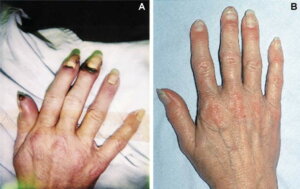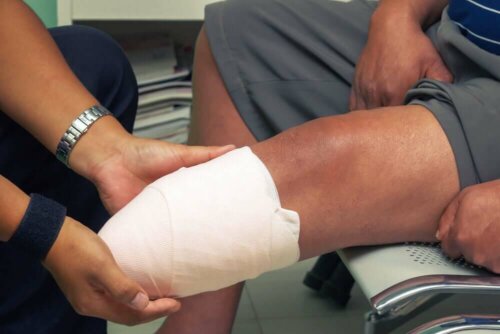Causes, Symptoms, and Treatment of Buerger's Disease


Written and verified by the doctor Leonardo Biolatto
Buerger’s disease is a rare disease that’s also called obliterative thromboangitis. It causes inflammation in certain blood vessels, like the arteries as well as medium and small caliber veins. That’s why it’s important to learn about possible treatments for Buerger’s disease.
In the vast majority of cases, people who suffer from this disease are smokers. And, although we don’t know much about its direct cause, it’s more frequent in certain geographic areas. For example, we see it more commonly in the Mediterranean and Southeast Asian countries.
The problem is that Buerger’s disease can have very serious consequences. One of them is that you may need to have a limb amputated. In today’s article, we’ll talk about the causes, symptoms, and treatment for Buerger’s disease.
What is Buerger’s disease?
Buerger’s disease is a condition that affects the blood vessels. It’s also called obliterative thromboangiitis. That’s because it causes inflammation in the blood vessels. Then, they get clogged because of the thrombi.
According to a study from Actas Dermo-Sifiliográfiica, most people with this disease are young men who smoke. It appears to be the result of an autoimmune mechanism that tobacco triggers.
Although it’s a rare disease, we have seen that most of the cases occur in the Mediterranean or Asian countries. After the blockage in the blood vessels takes place, the tissues stop receiving oxygenated blood.
Therefore, this condition damages the tissues and causes necrosis. Usually, this disease will affect your hands and feet the most. However, as the disease progresses, it can spread to your arms and legs as well. When your tissues die, you’re at a very high risk of having to undergo amputation.
Buerger’s disease symptoms
The symptoms associated with this disease are the result of the damage it does to your blood vessels. Since it damages both medium and small veins and arteries, it’s common to see issues in your extremities first.
Specialists from the Mayo Clinic explained that one of these symptoms is claudication. It causes pain in the feet, hands, arms, or legs that appears after you’ve used these extremities for a period of time. For example, it’s common to feel when you’re walking. Normally, the feeling will go away at rest.
Then, the lack of blood supply ends up causing skin damage. In addition, ulcers or necrotic areas may appear. It can also be caused by the cold or by stress, in addition to smoking.
Another typical symptom is Raynaud’s phenomenon. With this condition, your fingers or toes will turn pale because certain triggers are interrupting your blood flow. The most superficial veins will suffer from episodes of inflammation, which is called superficial thrombophlebitis.
Tobacco: The main cause of this disease

Buerger’s disease, as we’ve explained already, is associated with tobacco use. Smoking tobacco or chewing it can cause it, but we don’t know the exact cause. It seems to be an immune system reaction against tobacco itself.
The Spanish Academy of Dermatology and Venerology carried out a study that explains how there may be a certain genetic disposition to this condition. That would explain why only a small percentage of smokers develop this disease.
This theory is also supported by the fact that we see a higher prevalence of this disease in certain countries (Asia and the Mediterranean). Buerger’s disease is more common in people with the HLA-A9 haplotype.
Risk factors
Therefore, as you’ve seen, the most important risk factor is tobacco. And, you don’t have to smoke it. In addition, the more you consume, the great er probability that you’ll develop this condition.
Also, sex could play a role since it’s more common in men than in women. However, that could also be because, until very recently, men smoked more than women. We see most cases of this disease in young people who are under 45 years of age.
Buerger’s disease diagnosis
According to a study published in Integral Medicine, the diagnosis of Buerger’s disease is clinical. If a young patient starts experiencing the previously mentioned symptoms, and they’re a smoker without other risk factors, they should see a doctor.
Also, it’s important to rule out other autoimmune diseases or the possibility of a stroke. Several tests can help confirm this diagnosis, and the blood test is a basic one. This blood test can help rule out some other conditions, like scleroderma or bleeding disorders.
Angiography is another useful test. It allows you to check the condition of your veins and arteries if they may have been damaged. In addition, the Allen test allows your doctor to observe your arterial blood flow in the hand.
Buerger’s disease treatment
Since we don’t know the exact cause of this disease, experts haven’t been able to determine an ideal treatment for Buerger’s disease either. The only thing that we know for sure is that it’s essential to quit smoking.
In addition, the doctor will often prescribe anticoagulant treatments. For example, they may give the patient aspirin, heparin, and acenocoumarol. Those last two are generally prescribed when there’s a venous or arterial thrombosis.
Also, calcium antagonist drugs can be helpful, or some doctors may recommend a sympathectomy. This surgery consists of eliminating certain nerves from the sympathetic nervous system to avoid vasoconstriction.
However, if this disease has affected the patient’s blood flow for a long time and the tissues are damaged, they will need to undergo amputation. The doctor may need to remove a single finger or the entire hand or foot.

Possible complications
One of the most serious complications of this disease, as you’ve just read, is amputation. This is usually necessary when the tissues in the hands or feet die and gangrene occurs.
Gangrene is when one tissue dies due to a lack of blood supply or because of a severe bacterial infection. Symptoms often include black or bluish discoloration of the skin, an unpleasant odor, and loss of feeling.
Amputation is necessary because the infection can spread to the rest of the body if the doctor doesn’t amputate. Then, depending on which part of the body was amputated, the patient’s functionality and independence will be affected.
Conclusion
The truth is that scientists still don’t know the exact trigger of this disease. However, they do know that one of the main triggers is tobacco. Whether you smoke it or chew it, tobacco is the biggest risk factor.
In addition, tobacco is harmful to many other aspects of health. It can cause a multitude of cancers, like lung or lip cancer. That’s why it’s essential to avoid smoking or to quit as soon as possible.
Normally, it’s very difficult to quit if you’ve been using tobacco for years. However, today there are many methods and ways to help you take this step. For example, you can take medications and get the help of psychological therapies. In addition, you can always ask your doctor for help.
All cited sources were thoroughly reviewed by our team to ensure their quality, reliability, currency, and validity. The bibliography of this article was considered reliable and of academic or scientific accuracy.
- Tromboangeítis obliterante | Medicina Integral. (n.d.). Retrieved February 11, 2021, from https://www.elsevier.es/es-revista-medicina-integral-63-articulo-tromboangeitis-obliterante-10021657
- Enfermedad de Buerger (tromboangeítis obliterante) | Actas Dermo-Sifiliográficas. (n.d.). Retrieved February 11, 2021, from https://www.actasdermo.org/es-enfermedad-buerger-tromboangeitis-obliterante–articulo-13081640
- Enfermedad de Buerger – Síntomas y causas – Mayo Clinic. (n.d.). Retrieved February 11, 2021, from https://www.mayoclinic.org/es-es/diseases-conditions/buergers-disease/symptoms-causes/syc-20350658
- Enfermedad de Buerger (tromboangeítis obliterante) – ScienceDirect. (n.d.). Retrieved February 10, 2021, from https://www.sciencedirect.com/science/article/abs/pii/S0001731005731367
This text is provided for informational purposes only and does not replace consultation with a professional. If in doubt, consult your specialist.








